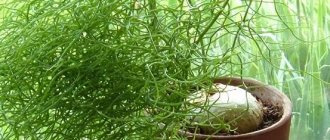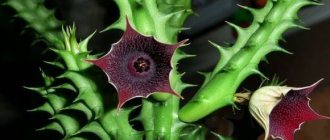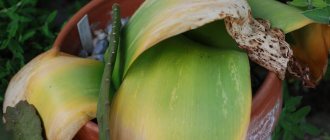Pedilanthus is a houseplant that came to us from America. Its curved, olive-colored stems and bright, as if made of wax, leaves attract the attention of all exotic lovers without exception. This flowering bush stands out effectively among other indoor flowers and is an interior decoration, no matter where you place it. Despite the abundance of Pedilanthus species, only a few have taken root at home. We will tell you about caring for them further.
Description of the plant
Pedilanthus is a succulent from the Euphorbiaceae family. Member of the genus Euphorbia (Euphorbia). This means that when cut or damaged, thick white sap flows out of the wounds of the plant. The name of the flower, Pedilanthus, comes from two Greek words "pedilon" (shoe) and "anthos" (flower). This is due to the appearance of the Pedilanthus inflorescence, which resembles a woman’s pump, fashionable, pink, with a pointed nose. And there are up to five dozen such miniature shoes on a plant at a time. It was as if little elves or fairies had kicked off their ballroom shoes to give their little feet a rest after dancing. Thanks to this, the flower has another name - “Fairy Shoes”.
The tropics and subtropics of South, Central and North America are considered the homeland of this succulent.
- In the semi-arid tropics, Pedilanthus are small deciduous flowering trees, up to three meters tall.
- In arid areas, these are succulents, the fleshy stems of which do not have leaves, but are adapted to accumulate moisture, retain it for a long time and spend it sparingly during difficult periods of life.
- In tropical rainforests, Pedilanthus are represented by abundantly branching, densely leafed flowering shrubs, up to two meters in height. A striking representative of this species is Pedilanthus titimaloides. It is he who is more adapted to life in captivity than other species.
The stems of tropical Pedilanthus are cylindrical and reach 1 cm in diameter. They are fleshy, zigzag-shaped, with tips where the leaves attach, and are dark olive or dull gray in color. For the unusual shape of its shoots, the local population of America calls Pedilanthus "Jacob's Ladder", and for the pungency and toxicity of its milky white juice - "The Devil's Backbone".
Seeing Pedilanthus for the first time in a flower shop, it is difficult to believe that this is a “living” representative of the flora. The flower seems to be the skillful work of a designer who managed to create a masterpiece out of plastic. Even potting soil is perceived as a clever marketing ploy. Nature plays the role of designer here. Once you see Pedilanthus, you will not forget it - it is so unusual and beautiful.
The leaves are oval or ovate in shape, with pointed tips and wavy edges. They are short-petioled or sessile. Hairless or pubescent. Dark or light green. Sometimes, with specks in the center. Like made of wax. Provided there is good lighting, the leaves become variegated with a white or slightly pinkish uneven edge. In some varieties, the edges of the leaves are fancifully bent, they become like boats. But, in a poorly lit place, the leaves become normal green.
Pedilanthus looks great indoors both as a single plant and in group plantings. Neighbors can be flowering, decorative foliage, and succulent plants.
Description
The homeland of pedilanthus is America, where the plant is well adapted to different climatic zones. In arid regions, this succulent has no leaves, but only thick stems that perfectly accumulate and retain moisture. In the semi-dry tropics these are already short trees with leaves, and pedilanthus grow and bloom most luxuriantly in humid tropical areas.
Interesting!
Pedilanthus, with its bright, dense leaves covered with natural wax, is often mistaken for an artificial plant. With proper care, it will always be a pearl in the collection of indoor plants.
Health Hazard
We would like to warn you that all parts of the plant are poisonous. Experienced flower growers know this, and all work with flowers is carried out using rubber gloves. If it comes into contact with exposed skin, the juice may cause burning and itching. Do not wait for the consequences and immediately wash these areas of the skin with warm water and soap several times. It will be worse if there are wounds or scratches on the skin. Then expect inflammation.
And if you want to try a beautiful leaf on your tooth, you will get poisoning - vomiting, nausea, loose stools.
Normally touching whole leaves and flowers of Pedilanthus with your bare hands will not cause you any harm .
However, we recommend keeping small children and pets away from contact with Pedilanthus. However, the seemingly poisonous juice of Pedilanthus is used in medicine in some countries for the production of antimicrobial and psychotropic drugs.
Diseases and pests
- The leaves of pedilanthus turn pink - this is a normal phenomenon, the leaves begin to turn pink when the plant is exposed to the sun for a long time, but they never become completely pink, only the border. This is their feature, their variegated form.
- Leaves are falling, what should you do - if the leaves begin to fall off during the dormant period, then the norm is for the leaves to drop up to 50%, but if this happens during active growth in spring or summer, it means that the plant’s conditions are not suitable.
- Drops leaves - the reason may be stagnation of moisture in the pot or drying out of the soil. Also a disadvantage, or vice versa, is exposure to direct sunlight on the plant.
- Why the leaves turn red - this is also an easy natural process, from bright lighting, but they do not become exactly red, but more of a scarlet hue.
- Spider mites, aphids and whiteflies can pose a danger to the plant - to combat them it is necessary to treat the plant with insecticides.
Signs and superstitions
It has been proven that Pedilanthus cleanses the air of toxic impurities, fills the room with oxygen and essential oils, which have antiseptic effects. So the plant belongs to the group of “green healers”. Also, some signs are associated with it:
- This flower, received as a gift, will bring changes to the interior of your home. Perhaps you will change the furniture or do a major renovation of one of the rooms.
- Placing a flower in your office suggests pleasant professional efforts with further promotion.
- Independent acquisition of Pedilanthus, for example, a cutting picked in a public place and planted by you, will become a symbol of professional growth and, possibly, a change from this place of work to a more prestigious one.
- According to some beliefs, variegated species of Pedilanthus drive away potential suitors. Unmarried virgins should not keep this flower at home.
Types and varieties of Pedilanthus
Despite the abundance of Pedilanthus species in their natural habitat, only 5 of them are most often grown at home.
Tithymaloides
Pedilanthus Tithymaloides
Tithymaloid is the most popular type of Pedilanthus among flower growers, which grows successfully in our apartments. It comes from the humid tropical forests of America, is very decorative and unpretentious. A small bush, with good care and timely pruning, quickly turns into a decorative indoor flower with waxy, variegated leaves. The stem changes direction of growth with the appearance of the next leaf.
This may be interesting: Sedum or Sedum - photos of species and varieties with descriptions
The surface of the leaf blade is slightly wrinkled. It can be colored green with a pinkish or olive tint and with light speckles in the center. The edges of the leaves are decorated with a white border. In late autumn, miniature inflorescences with bright pink or red bracts appear on the tops of the shoots. The flowers are shaped like a woman's shoe. Before flowering, the edges of the leaves turn pink, and this gives Pedilanthus titimaloides a spectacular appearance.
Large-fruited or Macrocarpus (Macrocarpus)
Pedilanthus Macrocarpus
This is a typical succulent, adapted to the hot climate of the subtropics. Its homeland is the desert regions of Mexico. It has thick fleshy stems of light green color with a bluish bloom. Instead of leaves, the stems are covered with barely noticeable small scales. Closer to winter, inflorescences with shiny, bright red bracts appear on the tops of the shoots. Thanks to the ability to accumulate and retain moisture for a long time with all parts of its body, this Pedilanthus is absolutely unpretentious when grown in a pot. It can easily withstand dry indoor air. If there is enough lighting, the flower will not cause you any trouble.
Finka (Finkii)
Pedilanthus Finkii
It is similar in appearance to Pedilanthus titimaloides, grows as a bush and has the same fleshy stepped stems. However, its leaves are shiny, smooth, bright green and without a border. The shoots grow in a zigzag pattern. The bulk of the leaves grow in the upper part of the plant; the lower leaves, as a rule, fall off and expose the stem. With the help of pruning, when growing in pots, it can be given the desired shape.
Spur (Calcaratus)
Pedilanthus Calcaratus
This evergreen plant has a woody type. In nature it grows several meters in height. The entire length of the spiral-shaped shoot is strewn with foliage - bright green, with wavy edges. Loves abundant watering and spraying. At home, they are grown in spacious rooms with high ceilings.
Nana
Pedilanthus Nana
This is a representative of the humid tropics, where it grows in the form of a bush. Loves the proximity of tall trees. In cultivation, it is grown most often in greenhouses and botanical gardens. The thick stem, beautiful, opposite leaves of dark green color and original broken shoots create the impression of an artificial plant. Nana loves high environmental humidity and loose, moisture-absorbing soils.
Pedilanthus general information
Some plants are purchased by home flower lovers for their attractive leaves, while others are purchased for their colorful flowers. And the plant, which will be discussed below, can please almost any gardener.
It attracts the attention of absolutely everyone. This amazing exotic plant comes from America.
This article will present everything related to the flower called pedilanthus: home care, types and varieties, what are the differences, and much more. etc.
The plant belongs to the Euphorbiaceae family. These are usually abundantly branching shrubs, mainly growing in the wild conditions of Central, North and South America.
- This genus is characterized by significant differences in habitat, so pedilanthus differ quite greatly in appearance.
- For example, Pedilanthus titimaloides is a small shrub that grows mainly in dry tropical forests.
- Spur pedilanthus and Finca, inhabitants of dry and wet forests, respectively, can have the appearance of a small tree.
- And the large-fruited pedilanthus is essentially an almost leafless succulent, the peculiarity of which is the presence of water-storing tissues in it.
The unusual shape of a flower in the form of a shoe is a characteristic difference between pedilanthus and other plants. This is why these flowers have become popular as indoor flowers.
Caring for Pedilanthus at home
The plant is quite unpretentious, but for its successful growth and flowering it requires appropriate conditions. Let us introduce you to them.
Location and lighting
Good illumination all year round is the main requirement of a flower for its place of residence. Place it on a south, south-west or south-east facing window sill in your apartment. It is better to place a grown flower on a table or flower shelf near the windows. It should be protected only from the hot midday sun; it is not afraid of the morning and evening sun. In summer, a flower pot can be taken out into the open air - onto a balcony, veranda, loggia, but it must be protected from precipitation and direct sunlight. You can take the pot out into the garden, where Pedilanthus will feel great in the openwork shade of the trees.
Temperature
Pedilanthus, like other tropical plants, loves warmth. During the growing season, spring and summer, it is advisable to maintain the air temperature in the range from 22 to 26 degrees. In winter, indoor Pedilanthus should have a dormant period. The temperature during it should be maintained from 15 to 17 degrees. Only under these conditions will flower buds be formed for flowering next year. It is important to protect the flower from the hot air of heating devices so that it does not drop all its leaves. You should ventilate the premises regularly, but first cover or move the flower pot away from the frosty air.
Humidity
Pedilanthus does not have any special requirements for ambient humidity. The dry air of our apartments suits him quite well. Only leafy species require periodic spraying of the crown, especially in winter, when the indoor air is dry from operating heating devices. Do not spray the flower after formative pruning or cuttings, because water getting on fresh cuts can lead to rotting of the shoots. Wait until the wounds dry out and then spray.
Watering
Pedilanthus has a negative attitude towards both the lack of moisture in the soil and overwatering. If you don't water the flower enough, it won't bloom. And overwatering can cause rotting of the roots, shedding of leaves and, again, lack of flowering. During the spring-summer period of active flower growth, the plant must be watered regularly, but moderately, without drying out the substrate or making it waterlogged. During the dormant period, from December to March, when you lower the temperature, you will need to reduce the amount of watering so that the top layer of soil dries out between waterings. Water for irrigation should be filtered or settled, at room temperature.
By the way, the leaves of Pedilanthus themselves tell you that it should be watered - they begin to droop.
Top dressing
Feeding is necessary for Pedilanthus for normal growth and flowering. This means from spring to autumn. Apply liquid fertilizer to succulents after regularly watering the plant once a month. Give preference to those fertilizers that contain phosphorus, iron and calcium. The content of nitrogen components should be minimal. Because an excess of nitrogen compounds leads to rotting of the root system and death of the bush. Strictly adhere to the recommended doses - it is better to underfeed the flower than to overfeed it.
The soil
Pedilanthus, like other succulents, prefers loose, light, moisture and breathable soil. It is acceptable to use ready-made soil from special stores intended for succulents. It is advisable to add a little sand here. If you are a fan of making your own soil, we can help you. To do this, mix 1 part each of turf and leaf soil, and one part of coarse river sand. Add a little vermiculite or moist coconut substrate to the mixture - these additives allow the soil to retain moisture and at the same time prevent the soil from souring.
This may be interesting: Aloe is the green doctor
Pot
A pot for planting and transplanting Pedilanthus can be used either plastic, clay or ceramic. It is important that the size of the pot matches the size of the plant's root system. It is small in succulents, and if you plant it in a pot that is too large, the substrate in it will turn sour. Young specimens should be planted in small pots, as for cacti.
At the bottom of any pot you should place a layer of drainage material equal to ¼ of the height of the pot. Add pieces of charcoal to expanded clay or pebbles as drainage for disinfection. Drainage holes at the bottom of the pot are required . Sometimes they are missing from plastic pots. Check your pot, and if there are no holes in the bottom, pierce them yourself with an awl or a large nail heated over gas.
Pedilanthus transplant
Pedilanthus does not need annual replanting, since its weak root system develops slowly. And this succulent does not need increased soil fertility, unless you recently purchased it at a flower shop. After all, in warehouses and stores, flowers are kept in temporary, transport pots that are not suitable for permanent maintenance of flowers. This Pedilanthus, just purchased and brought home, should be replanted.
Also, Pedilanthus should be replanted for the following reasons:
- roots come out of the drainage holes (this means the plant is cramped in the pot and needs to be transplanted into a new one);
- the base of the stem and roots of the plant rot.
If there is a need to transplant an adult Pedilanthus, we will tell you how to do it.
- Prepare a new pot, 1 - 2 cm larger than the previous one. The height and width of the pot should be approximately the same.
- Water the plant the day before transplanting.
- Carefully remove the flower from the pot, free the roots from the soil. Inspect them - remove damaged and rotten ones. Wash the roots with warm running water, then place them in a bright solution of manganese for 15 minutes, dry and sprinkle with crushed coal or cinnamon powder.
- Proceed to plant the plant in a new pot, which should already contain a layer of drainage and part of the new substrate for succulents. Place the root system in the center of the pot and start filling it with soil from the sides. Shake the pot slightly so that the substrate fills all the voids between the roots. Water it. If necessary, add more soil.
- Place the transplanted plant in light partial shade for 7–10 days to adapt. After that, you can move the pot to its permanent, well-lit place.
In those years when replanting is not required, we recommend removing the top 2–3 cm layer of substrate from the pot every six months and adding fresh soil instead.
Pruning Pedilanthus
Pruning is necessary not only to give the flower the desired original shape, for example, a beautiful tree or a charming palm tree, but also for the purpose of rejuvenation. Pedilanthus, compared to other indoor plants, grows quickly and grows in height faster than it expands in width. The absence of formative pruning will make the flower shapeless, its shoots will stick out in different directions, and the stem will become bare. Therefore, to get a beautiful and fluffy bush, start shaping it immediately after planting.
When it reaches a height of 20 cm, we recommend pinching its top - this will cause the stem to branch. Every spring, when the flower begins to grow, it is necessary to shorten the tops of the growing shoots by several centimeters. Also trim the longest branches that stick out to the side. Collect the plant sap that appears at the cutting sites with some soft paper napkin.
If you want to grow Pedilanthus as a multi-stemmed bush, use the cut apical cuttings for rooting (see section Propagation) and plant them in the same pot. Let two or three plants grow in one pot at once. The height of an adult Pedilanthus bush at home does not exceed one meter.
If your flower begins to lose its decorative appearance due to elongated and bare branches, we recommend that you cut it off radically in order to rejuvenate the bush. Leave hemp 5–6 cm high in the cut areas. Feed the plant at the root with complex fertilizer for flowering indoor plants. Very soon Pedilanthus will begin to grow and become even more beautiful than it was in his youth.
Bloom
At home, Pedilanthus blooms quite rarely. But it is still widely grown for its unique stems and leaves, which look like artificial works of art made from wax.
If you met all the requirements of Pedilanthus in terms of lighting and temperature conditions (it was hot in summer and cool in winter), if it rested well in winter, you can count on it to bloom. At home, Pedilanthus usually blooms in November - December, delighting its owner with bright flower-shoe inflorescences. As they wilt, remove the inflorescences with sharp scissors. When you remove the last flower, send the plant into winter dormancy.
Everything you need to know about transplanting, propagating and pruning pedilanthus
When pedilanthus appears in the collection on the windowsill, replanting, pruning and propagating the flower become important stages of care. This will allow you to enjoy the lush greenery and active growth of this amazing flower for many years.
Pedilanthus came among the indoor plants from the dry subtropics of Central and South America. Powerful stems and leathery leaves indicate in this culture a plant accustomed to withstanding sunlight and lack of moisture. On the rocky plains where pedilanthus grows, the soil is not rich in nutrients, and its layer is not very large. Such conditions are similar to those in which succulents live. However, unlike cacti, pedilanthus grows quite quickly and in nature can reach a height of 2.4 meters. This determines the specific care that the plant should receive at home.
Without limiting vertical growth, pedilanthus strives upward in the room, but the stems are very reluctant to branch and gradually become bare from below.
In order for a large, heavy plant to remain stable and decorative, regular replanting and pruning of pedilanthus is desirable. The cuttings obtained by pruning shoots are excellent planting material, quickly turning into young, brightly green specimens.
Reproduction of Pedilanthus
Most often, apical cuttings are used for propagation, and less often, plant seeds.
Propagation by cuttings
Propagating Pedilanthus by cuttings is a simpler method, but it also has its own nuances. It is best in the spring, during routine pruning of the plant, to cut the required number of cuttings (10 - 12 cm) from the tops of the shoots. Remove the lower leaves, leaving 5 - 6 leaves on the top. Place the cuttings for several hours in a container with clean warm water - let the secretion of milky juice stop. Now place the soaked cuttings on paper towels to dry.
This may be interesting: Sansevieria (Sansevieria) - unpretentious perfection
Fill a container or other flat container with damp vermiculite, sand or coconut shavings. Place the cuttings in this substrate, deepening their tips by 4 - 5 cm. You should not cover the seedlings with anything to avoid mold and rotting of the cuttings. Place the greenhouse in a warm, shaded place. The roots should appear in 2 - 3 weeks, and after another month the cuttings can be planted in separate small pots in a regular substrate for succulents.
Cuttings also root easily in a container of water. It is advisable to add an activated carbon tablet and a few drops of a root formation biostimulator to the water. But it’s possible without them. The roots appear quickly, develop well, and after a month or a month and a half they are ready for planting.
We recommend rooting 3–4 cuttings at a time. If you plant them in one pot, you will immediately get a voluminous, original-shaped bush. A lone branch will not be so attractive.
Propagation using seeds
You are unlikely to be able to obtain full-fledged seeds on your own. If you still want to try this method, we will focus on purchased seeds.
When buying seeds in a store, pay attention to their expiration date. (Expired seeds - do not buy). Sow the seeds in a substrate for succulents, adding one-third coarse river sand to it. Use a container with a lid or other container under the film to create a greenhouse effect. At first, until the seeds hatch, it is better to keep the greenhouse in the shade. Moderately moisten the substrate and ventilate as necessary.
When the shoots appear, the greenhouse should be moved to a more illuminated place in partial shade - direct sunlight can harm weak shoots. Gradually, begin to open the greenhouse more and more often and, finally, remove the shelter completely. The sprouts must grow and become stronger, only then transplant them into personal pots for further growth.
Reproduction
Pedilanthus propagates by cuttings. In the spring, when the plant is formed by pruning, a large number of apical cuttings remain ready for rooting. Cuttings are rooted in water, sand or perlite.
The cuttings are not given a greenhouse, as happens with cuttings of other plants. On the contrary, to prevent rot from forming, the container with the cuttings is left open.
The length of cuttings for rooting is at least 10 cm. There is no need to make them too long. Rooting time is from two weeks to a month. When the plant forms roots, the cuttings are planted in a substrate made up of sand and peat in equal proportions.
Good to know
Pedilanthus is a spurge plant, so when pruned it produces a milky sap. Before rooting, let the cuttings sit for 1–2 days to dry.
Seed propagation of pedilanthus, due to its labor-intensive and ineffective nature, is not used in indoor gardening.
Pedilanthus diseases and other home growing problems
Despite the fact that this succulent is considered unpretentious to the conditions, violations of the rules of care affect the development and flowering of Pedilanthus.
Pink leaf color is normal
Sometimes, amateur flower growers, when they discover that the white border on the leaves of Pedilanthus begins to turn pink, get scared, thinking that something wrong is happening to the plant. In fact, this is the norm. The leaf blades of the flower often change color in the summer, under the influence of light and heat, and in the fall, before flowering. This is a peculiar highlight of Pedilanthus.
If a plant sheds its leaves during a period of active growth, look for the cause in violation of temperature or watering regimes and drafts. If the leaves fall in winter, you should lower the temperature and reduce watering. Leave the lighting at maximum.
If the shoots stretch out, it means the flower does not have enough lighting. Shorten the shoots and place the pot in a brighter place. If necessary, add artificial lighting using a fluorescent lamp or phytolamp. Stretching of shoots and their thinning in winter occurs in too warm a room.
If the base of the stem and leaf petioles turn black, it means you are over-watering the plant and the roots have rotted. The same thing happens from a heavy and dense substrate. The flower urgently needs to be transplanted into new soil, having first removed the rotten parts of the plant and treated the healthy ones with some fungicide. (see transplant)
If the edges of Pedilanthus leaves dry out, the flower is exposed to the rays of the midday sun or the air in the room is too dry
If the leaves wither and droop, you are not watering the flower enough. Adjust the frequency of watering, do not allow the substrate to dry out in the future.
If Pedilanthus does not bloom , there may be several reasons:
- it lacks lighting;
- the temperature regime is violated;
- there was not enough winter rest period.
If various spots or gray plaque appears on the leaves of the plant or its shoots, most likely Pedilanthus has a fungal infection. Treat with Topaz fungicide, diluted according to the instructions. Three sprayings of the drug will be required at an interval of three days.
If the lower parts of the stem become very exposed as the flower grows, and it has lost its decorative appearance, trim the shoots so that stubs of 5–6 cm remain. If the root system is healthy, new, young and beautiful branches will grow soon. Such rejuvenation will benefit Pedilanthus.
Pruning pedilanthus
Like many indoor plants, pedilanthus has a period of relative rest, during which its development is slowed down. From spring to mid-autumn, the flower has an active growing season. The shoots are growing, new foliage appears. In February and early March, shortly before this, the gardener should think about pruning pedilanthus. If it is done on time:
- succulent flower stems do not lose much moisture;
- cut areas dry out quickly;
- over the summer the plant recovers;
- Removing the tips of the shoots triggers their branching, increasing the decorative effect of the flower.
Pedilanthus is not afraid of deep pruning, so with equal success you can pinch the very tips of the stems and shorten adult perennial shoots. In the latter case, for their renewal, several dormant buds are left above the ground level.
Pruning of pedilanthus is carried out with a sharp knife along the internode. Since the plant contains milky sap, which can impede healing, the sections are slightly dried and treated with crushed activated carbon. Before starting to form a pedilanthus bush, watering the flower is reduced and resumed in the same volume only after a few days.
The green parts of the plant remaining after pruning and replanting pedilanthus become excellent planting material when propagated.
Pests
Pedilanthus can be threatened by insect pests such as aphids, spider mites and whiteflies. How to recognize them?
- You will find aphids on the tops of green shoots in the form of small green or gray insects.
- Spider mites will appear on the underside of leaves in the form of dark spots and cobwebs. Appears only in very dry air. After treating the flower with an acaricide, take measures to increase the humidity in the room.
- The whitefly leaves behind sticky spots on the leaves. Whenever you touch a flower, small midges, white as ash, fly off it.
If you find any parasite, first take the flower to the bathroom and wash all its parts under a warm shower. You will wash away most of the parasites. But not everyone. Then treat the plant with some insecticide - a preparation against sucking insects (Fitoverm, Aktara, Aktellik or others) strictly according to the instructions. All indoor pests are very prolific and resilient. One time will not be enough to destroy the entire colony with eggs and larvae. Repeated processing is expected - read the instructions.
Pedilanthus transplant
Spring is the best time not only for pruning and propagation, but also for replanting pedilanthus. The plant should be transferred to a new pot only after the root system has occupied the entire volume of the previous one. The roots of this crop are not too large, so the flower will not have to be replanted very often.
The pot should be only 1–2 cm wider than before, and its depth should be equal to its diameter. Pedilanthus does not have any special requirements for the substrate. Ready-made mixtures for decorative deciduous crops or violets are best suited.
At the bottom of the container, a powerful drainage layer is installed, which prevents stagnation of moisture and acidification of the soil, which is dangerous for the plant.
Before replanting pedilanthus, the substrate, especially if it is made independently from a mixture of garden and turf soil, peat and sand, should be disinfected. This will prevent the plant from being infected by pests, pathogenic bacteria and fungi hiding in the soil.











